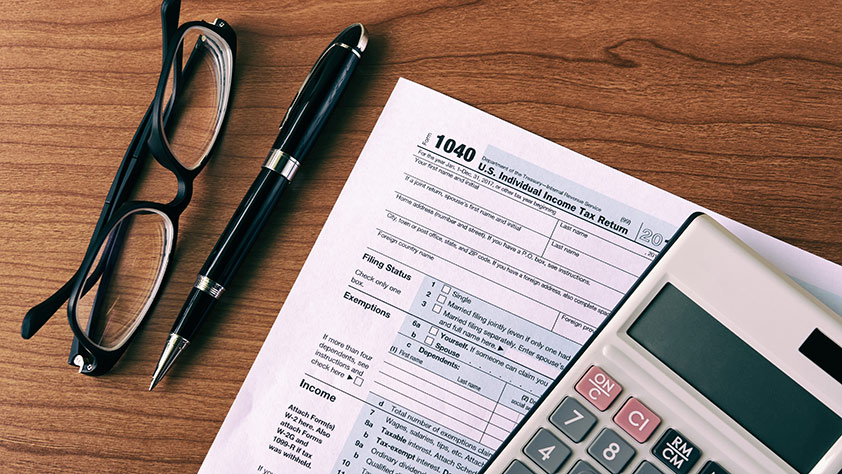Key takeaways
- Most retirement income is taxable except for withdrawals from Roth retirement accounts.
- Having taxable and non-taxable accounts gives you more tax planning flexibility.
- At a certain age, you must take minimum distributions from tax-deferred retirement accounts.
One of the biggest challenges in retirement is managing your retirement income so it lasts the rest of your lifetime. Many retirees spend a lot of time and effort on maintaining diversified investment portfolios and limiting principal withdrawals from their retirement accounts. While these strategies are important, many retirees overlook tax planning and may end up paying more money to Uncle Sam than necessary.
Give your retirement income taxable and non-taxable flexibility
Before you can put tax strategies in place, you need to understand which sources of income are taxable and which aren’t. Understanding how your retirement income is taxed and then selectively withdrawing money across different types of taxable and non-taxable accounts may offer the most flexibility for minimizing your tax bite.
Here’s a look at the two tax categories into which common retirement income sources fall.
1. Taxable category. Withdrawals and payments from the following sources are usually taxed at your regular income tax rate in the year you receive them:
- Pension payments
- Withdrawals of pre-tax contributions and all investment earnings from 403(b) plans, 401(k) plans, traditional IRAs and other tax-deferred retirement savings plans
- A portion of Social Security payments depending on certain criteria. Up to 85% of Social Security payments may be taxable if you have income from other sources.
- Interest on regular savings accounts and income from interest and dividends paid through taxable brokerage accounts
2. Non-taxable category. Income from the following sources is usually tax-free at the time of withdrawal:
- Withdrawals of any after-tax contributions (but not earnings on those contributions) made to 403(b) plans, 401(k) plans, traditional IRAs and other tax-deferred retirement savings plans
- Qualified withdrawals from Roth 403(b)s, Roth 401(k)s and Roth IRAs
- Social Security payments (if your income falls below certain limits)
- Certain municipal bonds
Decide how and when to take withdrawals from retirement accounts
You’ll want to design a withdrawal strategy from your retirement accounts, including the total percentage of assets you take out and which accounts you tap first.
A simple method that’s long been a default strategy for retirees entails taking withdrawals in this order:
- Required minimum distributions (RMDs) from retirement accounts
- Taxable accounts (savings, brokerage)
- Tax-deferred retirement accounts (403(b), traditional IRA)
- Tax-free retirement accounts (Roth 403(b), Roth 401(k), Roth IRA)
But there are no hard-and-fast rules. Everyone’s tax situation is unique and requires individual planning to get the most tax benefits. Plus, tax liabilities change over time. Tax rates may go up or down, and the balances in your taxable and non-taxable accounts may vary due to investment performance and withdrawals. You’ll have the most flexibility if you have money in all of these different account types. Then you can be nimble in how you take your withdrawals depending on your income and tax situation each year.
For example, if you have savings in both a 403(b) plan and a Roth IRA, you might withdraw just enough taxable income from the 403(b) to avoid getting bumped into a higher tax bracket. You could then take tax-free withdrawals from the Roth IRA for additional income without paying more taxes.
Remember to take required minimum distributions (RMDs)
Once you reach a certain age, the IRS requires you to take minimum distributions from all tax-deferred retirement accounts each year whether you need the income or not. These distributions are taxable, so they will drive your decisions on where to take other withdrawals in order to minimize your tax burden.
- Under the SECURE Act 2.0 of 2022, the age for beginning required minimum distributions (RMDs) from most qualified retirement plans increased from 72 to 73. In practical terms, the law requires individuals who turned 73 in 2023 to take their first RMD by December 31, 2023—but because a three‐month grace period is allowed on that first RMD, the participant may delay taking it until April 1, 2024, without incurring a penalty. For every distribution year thereafter—including for calendar year 2024—RMDs must be taken by December 31 of the applicable year. (Later provisions of the SECURE Act 2.0 eventually increase the RMD age to 75 for those born on or after January 1, 1951, with the adjustment phased in over time.)
- For individuals who delay their first RMD until April 2024 (by using the three month grace period), the second RMD will be calculated based on the account balance as of December 31 of the previous year and must be distributed by December 31 of the current year. In effect, some individuals may end up taking two distributions in the year they elect to delay the first one. The new threshold age of 73 applies uniformly going forward.
The IRS is very strict about enforcing RMD rules, so make sure you calculate your RMDs correctly and make them on time. If you’re late, you’ll owe a penalty equal to 50 percent of the amount that should have been withdrawn.
Get creative to limit tax liabilities
You can use many of the same tax limiting strategies in retirement that you did when you were working and earning a paycheck.
- File itemized tax returns so that you can maximize deductions (if you have the deductions)
- Make charitable gifts
- If you are in the lowest tax brackets, you may be able to sell stocks and take long-term capital gains tax-free
- If you are in higher tax brackets, you may be able to sell stocks at a loss to offset a portion of your income
- Work with a financial planner and tax adviser to take advantage of all your options
Summary
In summary, retirement tax planning is complex because it involves:
- Timing and sizing the distributions (including RMDs) that directly influence your taxable income.
- Decisions to maintain your assets in tax-deferred, tax-exempt and/or taxable accounts—including potential conversions from a traditional IRA to a Roth IRA—each with its own advantages and pitfalls.
- Navigating specific rules and exceptions regarding withdrawals, rollovers and prohibited transactions, which require meticulous attention to detail.
- Potential international tax considerations for retirees residing outside the United States or those who are subject to treaty provisions.
Each element must be analyzed not only on its own but also in terms of how it interacts with other elements of your retirement income, tax bracket, investment strategy and long-term financial goals. Working with a qualified tax professional to craft a strategy that reflects your specific situation and remains flexible for changes in tax laws is essential.












